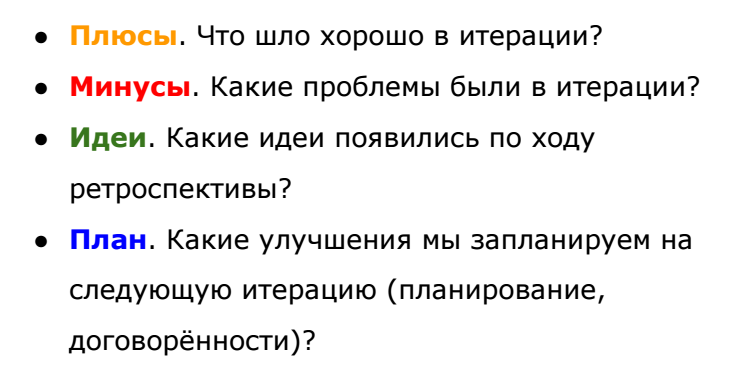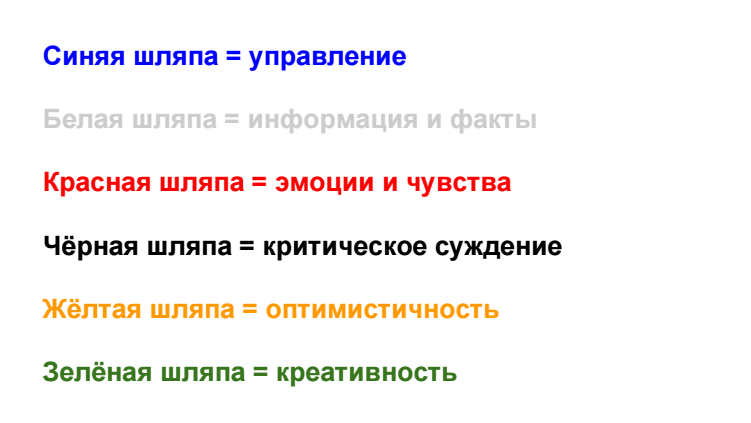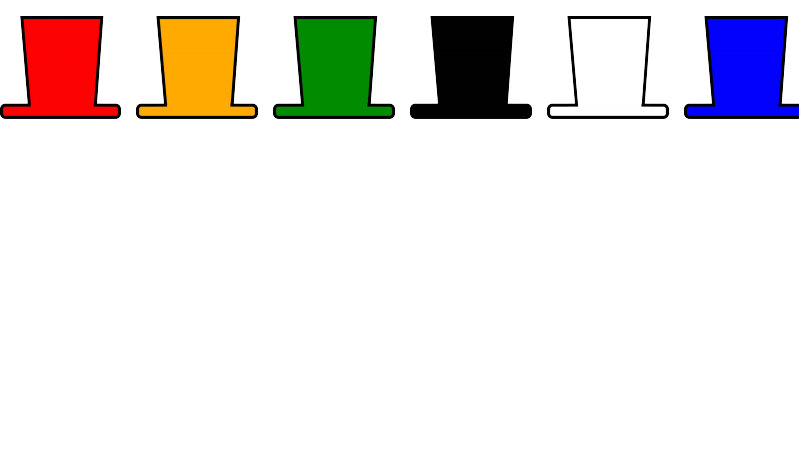Six-hat retrospective
In the next few paragraphs, I want to share my experience of conducting a retrospective using the six-hat method not so long ago. The Six Thinking Hats method is a method of organizing thinking that helps to look at a problem from different angles, as well as one of the varieties of brainstorming when working in a team.
It will be interesting to those who are looking for new ways to conduct retrospectives, who are interested in teamwork, approaches to decision making and generation of ideas.
The purpose of the text is to tell you that there is such a method, based on a simple example, to show how it can be used to organize retrospectives; arouse the interest of the reader for further independent study of this method.
The idea of using the six-hat method for conducting a retrospective came up when I was looking for interesting retrospective options for student developers: the guys had the task of creating a student portal, sprint = 1 week, at the end of the week a retrospective for one pair (pair - 1.5 hours). I really wanted to organize a couple in such a format as to interest even those who are not actively involved in direct development, and those whose portal development process itself did not arouse any enthusiasm. Another of the important conditions is to share knowledge that the guys could use later in their daily lives (as it turned out, none of those present before the couple had heard of this method).
About the method of six hats quite a lot has been written in a variety of sources and in relation to solving a wide variety of problems. Below I will only briefly describe what it is.
The six-hat method is a method of organizing thinking , one of the most popular ways of brainstorming.
It is no secret that human thinking is very chaotic: here emotions are mixed with common sense, and intuition, and facts. And what if the next time you need to make a decision or generate an idea, consistently apply: facts; feelings; critical thinking; a positive view of the problem; creative thinking? Speaking in the context of the method, try on each of the six hats: white (information and facts), red (emotions and feelings), black (critical judgment), yellow (optimism), green (creativity). There is also a blue hat - it discusses the organization of the process of successive “fitting” of hats (for more details, see, for example, the Wikipedia article - each of the six hats is well-painted there and examples are given).
In the most straightforward sense, Retrospective is a meeting with the project team to complete the sprint in order to discuss this sprint itself, its results : the classic “What was good?”, “What were the problems”, “What ideas for improvement?”, “What were planned for the next sprint?". Those. it is necessary to voice and recognize the team’s problems that the team encountered during the sprint, to note the positive aspects, to come up with how to live effectively, and it’s very important that no team member is left out of the discussion.
And it’s cool to look at the past sprint from different positions and, if possible, not to miss anything important. I will not deceive if I say that retrospective is also an opportunity to rally the team. And the six-hat method can be an effective tool in all of this.
For example, I will tell you how this happened with us. First of all, it was very important that the guys did not forget what the purpose of our meeting was. For this, for example, you can put a retrospective plan in front of your eyes:

All these are the main goals of conducting a retrospective (taken from here ).
Well, the six-hat method is what helps to achieve this goal, and then it's time to explain to the team what this method is and why we need it. Here, I think, it’s enough to confine ourselves to a concise explanation for 4 minutes with brief simple examples (it’s more understandable than directly diving into the retrospective using the six-hat method, it still cannot be done at this stage). So that information is not lost in your head and no more time is wasted on questions, you can hang a simple cheat sheet in front of your eyes, for example:

After the team has a general idea of the method, it's time to immerse yourself in it and start with a blue hat.
Blue hat = control
At this step, you need to tell how a retrospective will be carried out today according to the method, for example: the team will try on each of the hats one by one, this will help to look at different angles from the main issues of the retrospective (those in the picture above). At the same time, it is very important to limit the time spent in each of the hats (how much depends on how long the retrospective is originally planned) - this is how the team manages to discuss the important and does not have time to plunge into unnecessary wilds. Well, do not forget to leave time to take stock.
White hat = information and facts
Here, everyone voices the facts about the current sprint, for example:
Facts must be objective, can be both positive and negative - it is important to separate them from each other.
Red hat = emotions and feelings
In this hat, team members voice their feelings from the past sprint, demonstrate emotions (it is important that there are no transitions to personalities). Like facts, emotions and feelings can be either positive or negative, but most importantly, clearly articulated.
Critical Judgment
Here you can cast a glance at the facts already fixed and criticize them (objectively criticize). For instance,
etc.
Yellow hat = optimism
In this hat we highlight the positive points: what was good in the sprint (“As a result of the sprint, the team worked well”, “Petya, it turns out, is a cool front worker! It helped us a lot with such and such a task”, “The show was great, we are good fellows ”), that will be good (“ With such a front worker as Petya ... ”- well, you understand).
Green hat = creativity
For this stage, the team has already recorded facts about working during the sprint, highlighted the pros and cons. It's time to look at all this again: how to avoid the voiced minuses in the next sprint? How not to lose and use the pros in the next sprint? Here we generate and capture ideas on how to improve the team's work for the next sprint.
Summarizing
Based on the results of the retrospective, the team should have an improvement plan for the next sprint - it is formed from what was generated in the green hat. I won’t write about what the improvement plan should look like based on the results of a retrospective - in the framework of this article, such a task is not worth it.
Above is a short description of how you can retrospectively use the six-hat method. I hope that the article helped to discover something new for myself and / or to structure the existing perception. It was not a goal to tell what a retrospective is, and even a goal to write instructions on how to conduct a retrospective using the six-hat method was not worth it, I just wanted to tell what else happens like this - know this and use this knowledge. Cool and entertaining retrospectives to you :)
PS The way it looked with us:

It will be interesting to those who are looking for new ways to conduct retrospectives, who are interested in teamwork, approaches to decision making and generation of ideas.
The purpose of the text is to tell you that there is such a method, based on a simple example, to show how it can be used to organize retrospectives; arouse the interest of the reader for further independent study of this method.
Instead of joining
The idea of using the six-hat method for conducting a retrospective came up when I was looking for interesting retrospective options for student developers: the guys had the task of creating a student portal, sprint = 1 week, at the end of the week a retrospective for one pair (pair - 1.5 hours). I really wanted to organize a couple in such a format as to interest even those who are not actively involved in direct development, and those whose portal development process itself did not arouse any enthusiasm. Another of the important conditions is to share knowledge that the guys could use later in their daily lives (as it turned out, none of those present before the couple had heard of this method).
What is the six hat method
About the method of six hats quite a lot has been written in a variety of sources and in relation to solving a wide variety of problems. Below I will only briefly describe what it is.
The six-hat method is a method of organizing thinking , one of the most popular ways of brainstorming.
It is no secret that human thinking is very chaotic: here emotions are mixed with common sense, and intuition, and facts. And what if the next time you need to make a decision or generate an idea, consistently apply: facts; feelings; critical thinking; a positive view of the problem; creative thinking? Speaking in the context of the method, try on each of the six hats: white (information and facts), red (emotions and feelings), black (critical judgment), yellow (optimism), green (creativity). There is also a blue hat - it discusses the organization of the process of successive “fitting” of hats (for more details, see, for example, the Wikipedia article - each of the six hats is well-painted there and examples are given).
Cool, but how does this help when conducting a retrospective?
In the most straightforward sense, Retrospective is a meeting with the project team to complete the sprint in order to discuss this sprint itself, its results : the classic “What was good?”, “What were the problems”, “What ideas for improvement?”, “What were planned for the next sprint?". Those. it is necessary to voice and recognize the team’s problems that the team encountered during the sprint, to note the positive aspects, to come up with how to live effectively, and it’s very important that no team member is left out of the discussion.
And it’s cool to look at the past sprint from different positions and, if possible, not to miss anything important. I will not deceive if I say that retrospective is also an opportunity to rally the team. And the six-hat method can be an effective tool in all of this.
For example, I will tell you how this happened with us. First of all, it was very important that the guys did not forget what the purpose of our meeting was. For this, for example, you can put a retrospective plan in front of your eyes:

All these are the main goals of conducting a retrospective (taken from here ).
Well, the six-hat method is what helps to achieve this goal, and then it's time to explain to the team what this method is and why we need it. Here, I think, it’s enough to confine ourselves to a concise explanation for 4 minutes with brief simple examples (it’s more understandable than directly diving into the retrospective using the six-hat method, it still cannot be done at this stage). So that information is not lost in your head and no more time is wasted on questions, you can hang a simple cheat sheet in front of your eyes, for example:

After the team has a general idea of the method, it's time to immerse yourself in it and start with a blue hat.
Blue hat = control
As I noted above, the blue hat is the organization and discussion of the process, in our case, a retrospective. In the context of Ajail, a blue hat is a Scrum master's hat for the duration of the entire retrospective (it is he who organizes the discussion process and monitors its consistency and effectiveness).
At this step, you need to tell how a retrospective will be carried out today according to the method, for example: the team will try on each of the hats one by one, this will help to look at different angles from the main issues of the retrospective (those in the picture above). At the same time, it is very important to limit the time spent in each of the hats (how much depends on how long the retrospective is originally planned) - this is how the team manages to discuss the important and does not have time to plunge into unnecessary wilds. Well, do not forget to leave time to take stock.
It is important that all information obtained in retrospect is recorded, and when using the six-hat method, it is also structured. For this purpose, I brought the slide to the marker:
- it is assumed that all voiced thoughts will be recorded under each of the hats (depending on which hat the thought was generated in).
White hat = information and facts
Here, everyone voices the facts about the current sprint, for example:
- We didn’t have time to do such and such tasks,
- The show went well, the customer was satisfied,
- Kolya (Petya, Kayum) was thrown to the front end, because the guys did not have time.
Facts must be objective, can be both positive and negative - it is important to separate them from each other.
Red hat = emotions and feelings
In this hat, team members voice their feelings from the past sprint, demonstrate emotions (it is important that there are no transitions to personalities). Like facts, emotions and feelings can be either positive or negative, but most importantly, clearly articulated.
Critical Judgment
Here you can cast a glance at the facts already fixed and criticize them (objectively criticize). For instance,
- If the skills of the performers were taken into account when planning the tasks, then we would not have spent time trying to teach Petya how to work with the assembly system,
- If the quality of the user cases were higher, then so much time would not have been spent trying to figure it out (in this case, it should be indicated what the quality of the user cases is higher!),
etc.
Yellow hat = optimism
In this hat we highlight the positive points: what was good in the sprint (“As a result of the sprint, the team worked well”, “Petya, it turns out, is a cool front worker! It helped us a lot with such and such a task”, “The show was great, we are good fellows ”), that will be good (“ With such a front worker as Petya ... ”- well, you understand).
Green hat = creativity
For this stage, the team has already recorded facts about working during the sprint, highlighted the pros and cons. It's time to look at all this again: how to avoid the voiced minuses in the next sprint? How not to lose and use the pros in the next sprint? Here we generate and capture ideas on how to improve the team's work for the next sprint.
Summarizing
Based on the results of the retrospective, the team should have an improvement plan for the next sprint - it is formed from what was generated in the green hat. I won’t write about what the improvement plan should look like based on the results of a retrospective - in the framework of this article, such a task is not worth it.
Instead of a conclusion
Above is a short description of how you can retrospectively use the six-hat method. I hope that the article helped to discover something new for myself and / or to structure the existing perception. It was not a goal to tell what a retrospective is, and even a goal to write instructions on how to conduct a retrospective using the six-hat method was not worth it, I just wanted to tell what else happens like this - know this and use this knowledge. Cool and entertaining retrospectives to you :)
PS The way it looked with us:


